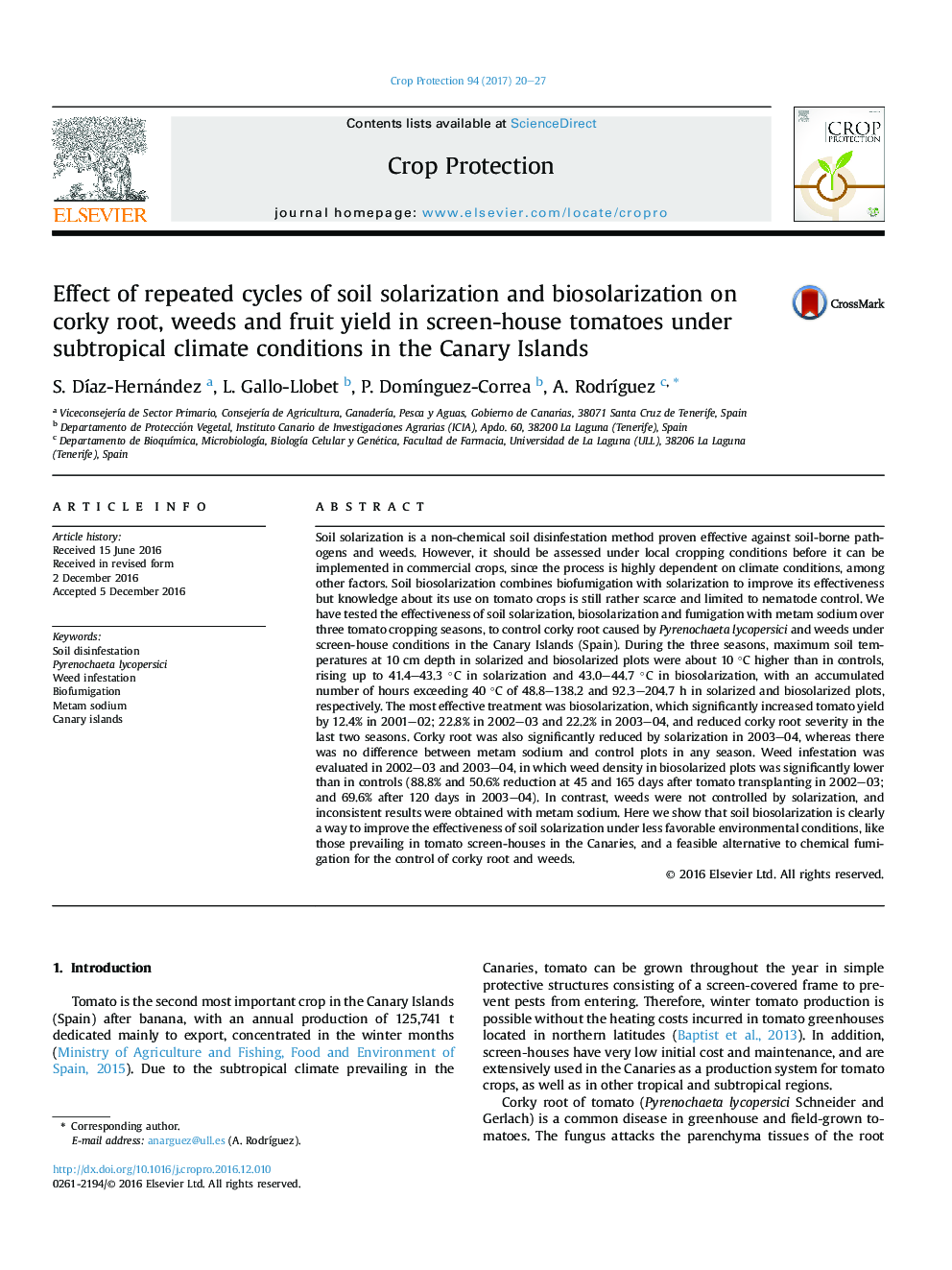| کد مقاله | کد نشریه | سال انتشار | مقاله انگلیسی | نسخه تمام متن |
|---|---|---|---|---|
| 5760918 | 1624293 | 2017 | 8 صفحه PDF | دانلود رایگان |
عنوان انگلیسی مقاله ISI
Effect of repeated cycles of soil solarization and biosolarization on corky root, weeds and fruit yield in screen-house tomatoes under subtropical climate conditions in the Canary Islands
ترجمه فارسی عنوان
تأثیر چرخه های مکرر تابش خورشیدی و بیوسولاریزاسیون بر ریشه های کاشت، علف های هرز و عملکرد میوه در گوجه فرنگی های روی صفحه در شرایط آب و هوایی جو سدیم در جزایر قناری
دانلود مقاله + سفارش ترجمه
دانلود مقاله ISI انگلیسی
رایگان برای ایرانیان
کلمات کلیدی
موضوعات مرتبط
علوم زیستی و بیوفناوری
علوم کشاورزی و بیولوژیک
علوم زراعت و اصلاح نباتات
چکیده انگلیسی
Soil solarization is a non-chemical soil disinfestation method proven effective against soil-borne pathogens and weeds. However, it should be assessed under local cropping conditions before it can be implemented in commercial crops, since the process is highly dependent on climate conditions, among other factors. Soil biosolarization combines biofumigation with solarization to improve its effectiveness but knowledge about its use on tomato crops is still rather scarce and limited to nematode control. We have tested the effectiveness of soil solarization, biosolarization and fumigation with metam sodium over three tomato cropping seasons, to control corky root caused by Pyrenochaeta lycopersici and weeds under screen-house conditions in the Canary Islands (Spain). During the three seasons, maximum soil temperatures at 10 cm depth in solarized and biosolarized plots were about 10 °C higher than in controls, rising up to 41.4-43.3 °C in solarization and 43.0-44.7 °C in biosolarization, with an accumulated number of hours exceeding 40 °C of 48.8-138.2 and 92.3-204.7 h in solarized and biosolarized plots, respectively. The most effective treatment was biosolarization, which significantly increased tomato yield by 12.4% in 2001-02; 22.8% in 2002-03 and 22.2% in 2003-04, and reduced corky root severity in the last two seasons. Corky root was also significantly reduced by solarization in 2003-04, whereas there was no difference between metam sodium and control plots in any season. Weed infestation was evaluated in 2002-03 and 2003-04, in which weed density in biosolarized plots was significantly lower than in controls (88.8% and 50.6% reduction at 45 and 165 days after tomato transplanting in 2002-03; and 69.6% after 120 days in 2003-04). In contrast, weeds were not controlled by solarization, and inconsistent results were obtained with metam sodium. Here we show that soil biosolarization is clearly a way to improve the effectiveness of soil solarization under less favorable environmental conditions, like those prevailing in tomato screen-houses in the Canaries, and a feasible alternative to chemical fumigation for the control of corky root and weeds.
ناشر
Database: Elsevier - ScienceDirect (ساینس دایرکت)
Journal: Crop Protection - Volume 94, April 2017, Pages 20-27
Journal: Crop Protection - Volume 94, April 2017, Pages 20-27
نویسندگان
S. DÃaz-Hernández, L. Gallo-Llobet, P. DomÃnguez-Correa, A. RodrÃguez,
